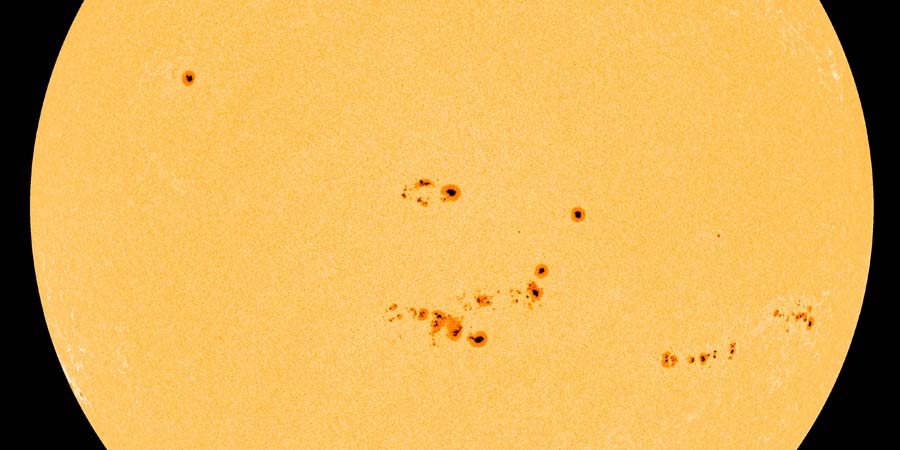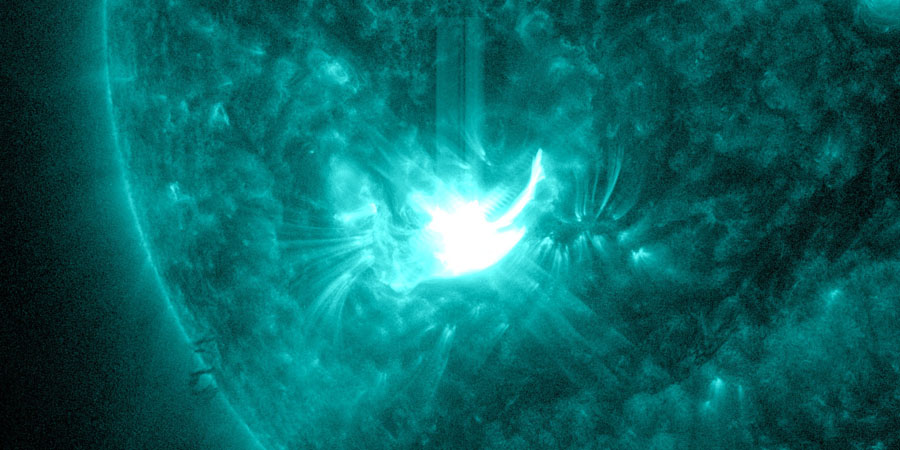Latest news updates Subscribe
G3 geomagnetic storm watch due to CME passage
czwartek, 12 września 2024 17:57 UTC
Earlier today we saw the arrival of one but perhaps even multiple coronal mass ejections at our planet. Geomagnetic storm conditions up the G3 (Kp7) level have already been observed but we are still very much under the influence of these coronal mass ejections as they pass Earth.
Severe G4 geomagnetic storm
poniedziałek, 12 sierpnia 2024 15:11 UTC
Severe G4 geomagnetic storm conditions have now been observed which stands for a Kp of 8!
Solar maximum is here! G2 storm watch and X-flare!
czwartek, 8 sierpnia 2024 20:16 UTC
Our Sun has been very busy the past few weeks and we have now reached the highest official monthly mean sunspot number in 23 years during the month of July! We landed on a whopping 196.5 and August thus far averages an incredible monthly mean sunspot number of 222.3! Is this going to be solar maximum when we look back at Solar Cycle 25 in the coming years? It seems likely!
G3 geomagnetic storm watch
poniedziałek, 29 lipca 2024 16:12 UTC
Good day everyone. We hope all of our visitors are enjoying their summer or of course their winter for the folks down under! We sure have been enjoying our summer break after what was a crazy month of May for the website during the period of the extreme G5 geomagnetic storm. Our apologies for the lack of updates despite the fairly active space weather but it is good to see many of our users activity using the app and enjoying the automated alerts to keep them informed. As a lot of you have noticed that your phone has been vibrating a lot due to high flaring activity on the Sun. As a matter of fact we have had at least one M or X-class solar flare every day ever since the 13th of July!
X1.2 solar flare
niedziela, 14 lipca 2024 12:23 UTC
It is July 14th and that calls for fireworks. We congratulate our French friends with their national holiday, Bastille Day, and so does our Sun.
Old sunspot region 3664 returns with an M9.3 solar flare!
niedziela, 23 czerwca 2024 15:15 UTC
Old sunspot region 3664 and more recently 3697 is back for a third visit of the earth-facing solar disk. The region received sunspot number 3723 and immediately announced its return with an impulsive and non-eruptive M9.3 (R2-moderate) solar flare that peaked at 13:01 UTC. It has decayed heavily as expected of course but there still seems to be some gas in the tank for major eruptions! Exciting!
CME impact, X1.5 solar flare
poniedziałek, 10 czerwca 2024 17:16 UTC
The anticipated M9.3 coronal mass ejection has arrived at our planet. As expected, it looks like a glancing blow with the solar wind speed increasing to a modest 430km/s with the interplanetary magnetic field strength (Bt) increasing to about 15nT. A minor G1 geomagnetic storm watch is in effect for the remainder of today.
M9.3 solar flare, S3 proton storm, Earth-directed CME
sobota, 8 czerwca 2024 15:29 UTC
Sunspot region 3697 has been relatively quiet the past few days as she made her way towards the west limb but she was not planning to exit stage right without one final song. At 01:49 UTC this night the region produced a highly eruptive long duration M9.7 (R2-moderate) solar flare.
Double impulsive X-class flares
sobota, 1 czerwca 2024 15:48 UTC
Two X-class solar flares (X1.1 and X1.3) took place during the past 24 hours peaking at 22:03 UTC (31 May) and 08:48 UTC (1 June). These were impulsive events which originated from sunspot region 3697. Both of these events were not eruptive and did not launch coronal mass ejections.
X1.4 solar flare from sunspot region 3697
środa, 29 maja 2024 19:13 UTC
Ex-3664 which is now numbered as sunspot region 3697 is at it again this time with a long duration X1.4 solar flare (R3-strong) that peaked at 14:37 UTC.
Najnowsze wiadomości
Najnowsze wiadomości z forum
Więcej tematówWesprzyj SpaceWeatherLive.com!
Wiele ludzi odwiedza stronę SpaceWeatherLive, aby śledzić aktywność słońca lub czy jest szansa na zobaczenie zorzy, ale większy ruch powoduje większe koszty utrzymania serwerów. Jeżeli podoba ci się strona SpaceWeatherLive i chciałbyś/chciałabyś wesprzeć ten projekt to możesz kupić subskrypcje aby uzyskać dostęp do strony bez reklam lub kupić darowiznę. Dzięki waszej pomocy, pomagacie utrzymać serwery SpaceWeatherLive!
Fakty na temat pogody kosmicznej
| Ostatnie rozbłyski klasy X | 2025/12/08 | X1.1 |
| Ostatnie rozbłyski klasy M | 2025/12/27 | M5.1 |
| Ostatnia burza geomagnetyczna | 2025/12/22 | Kp5 (G1) |
| Dni bez plam słonecznych | |
|---|---|
| Ostatni dzień bez plamy słonecznej | 2022/06/08 |
| Średnia miesięczna liczba plam słonecznych | |
|---|---|
| listopada 2025 | 91.8 -22.8 |
| grudnia 2025 | 115.5 +23.7 |
| Ostatnie 30 dni | 113.8 +28 |















